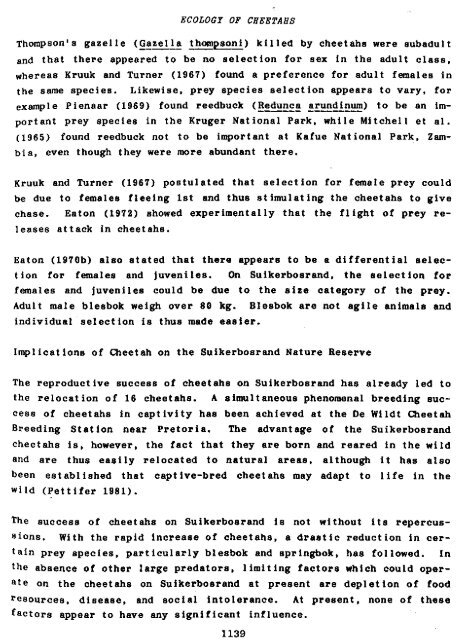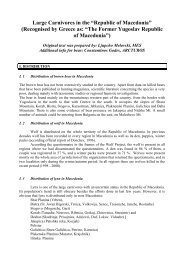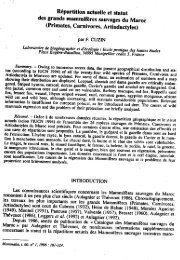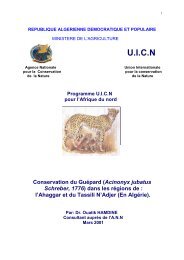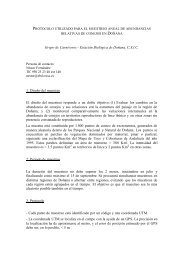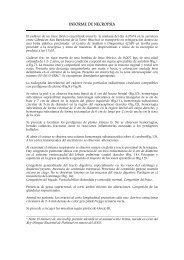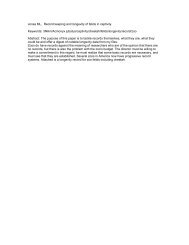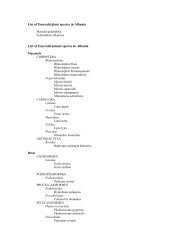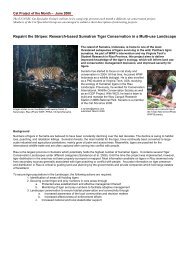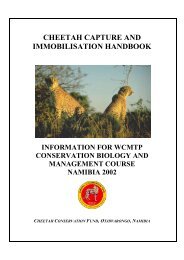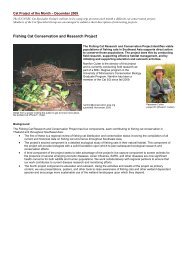Pettifer HL. 1981. Aspects on the ecology of cheetahs on the ...
Pettifer HL. 1981. Aspects on the ecology of cheetahs on the ...
Pettifer HL. 1981. Aspects on the ecology of cheetahs on the ...
You also want an ePaper? Increase the reach of your titles
YUMPU automatically turns print PDFs into web optimized ePapers that Google loves.
ECOI.OCI OF CEEETAES<br />
Thomps<strong>on</strong>'a sarelle (99!glq<br />
1!9qp!99) killed by <strong>cheetahs</strong> were gubadult<br />
and that <strong>the</strong>re appea.eal to bo no seloctl<strong>on</strong> for rex ln ihs adult class,<br />
rhe.eas Kruuk rnd Turne! (196?) found a plefere|rce for adult f€r[ales in<br />
<strong>the</strong> same species. Lik€wise, ptey 3peciea selectl<strong>on</strong> appears to vuy, for<br />
exornple Pie|rarr (1969) found leedbuck (Bedunca arundtnun) to be rn lmportant<br />
prey species in <strong>the</strong> Xruge! Nati<strong>on</strong>al Park, rhll6 Mltchell et al.<br />
(1965) found reedbuck not to be lmportant at Kafue Nati<strong>on</strong>rl Park, Zam-<br />
bia, even though <strong>the</strong>y were more abundint <strong>the</strong>ae.<br />
Xruux and Turner (lg8?) poEtulrted that selectl<strong>on</strong> for feoale prey could<br />
be due io feoaler tl.elng lst snd thuB sttmulatlng <strong>the</strong> <strong>cheetahs</strong> to glve<br />
cha6e. Eat<strong>on</strong> (19?2) Bhowed expe!iDentally that <strong>the</strong> flight ol prey re-<br />
leasea at t ack in <strong>cheetahs</strong>.<br />
Eat<strong>on</strong> (19?0b) elao atated that thcro rpDear8 to be a dlffelential 60lec-<br />
tl<strong>on</strong> for females rnd Juvenilcs. On Sulkerbosranal, <strong>the</strong> aslectlor| lor<br />
fsDalea and iuvenlle3 could b6 due to <strong>the</strong> alr. celeSoty <strong>of</strong> <strong>the</strong> pr6y.<br />
Adult male blesbok relgh ov6r 80 kg. El6abok ere not eglle rnimala lnd<br />
lndividual aelecti<strong>on</strong> ia thue mral6 ee6l€r.<br />
Implicall<strong>on</strong>s <strong>of</strong> Cheetah <strong>on</strong> <strong>the</strong> Suikerbosrand Nature Reaerve<br />
The reproductlve succesa ot che6trha <strong>on</strong> Suikerboarand has already led to<br />
<strong>the</strong> relocrti<strong>on</strong> <strong>of</strong> l6 che€trhs. A almultaneouB ph€noh€nal breedlng succes8<br />
<strong>of</strong> cheetshs in captlvlty hea been achleved at <strong>the</strong> De Wlldt qreetah<br />
Breedlng Stetl<strong>on</strong> noer Pretorlr. The rdvantsge <strong>of</strong> th. Suikelbosrand<br />
cheetah8 ls, however, <strong>the</strong> tact thrt <strong>the</strong>y are bo.[ anal r€ared ln <strong>the</strong> wild<br />
and are thus eaally reloc|ted to [rtural ar€aB, although lt has also<br />
been establlshed that capt lye-bred cheetah6 otry adapt to lile ln <strong>the</strong><br />
l{i ld (Pet t t l€r 1S81).<br />
The success <strong>of</strong> che€tahs <strong>on</strong> Suikerbosarnd ls not wlthout lts repotcus-<br />
sr<strong>on</strong>s. Wlth <strong>the</strong> r.apid lncreaae <strong>of</strong> cheetaha, e alrertlc reduct l<strong>on</strong> ln cs!-<br />
taln prey species, prrtlculerly bl€sbok and sprlngbok, has followed. tn<br />
<strong>the</strong> absenc6 <strong>of</strong> oth€r lsrge predrtors, limttlng fuctors lfhlch could opor-<br />
ate <strong>on</strong> <strong>the</strong> cheetrhs <strong>on</strong> Sulkorboarand at p!€sent rre depl6tl<strong>on</strong> <strong>of</strong> food<br />
resourcea, dl6€rae, end soclal lntol€rrnce. At pr€a€nt, n<strong>on</strong>e <strong>of</strong> thsa6<br />
factore appeer to have dny slgntllcant ln!luence.<br />
1139


